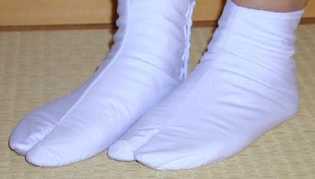足袋 - Tabi
A few days ago, while touring Bukeyashiki, the old samurai residence, I was reminiscing about some of the old customs of clothing such as Yukata, Kimono, Suteteko, etc. Then I got to footwear and who wore the cloth shoes called Tabi.Most of which are made of cotton. I have seen Tabi in many places and recently have seen rubber-soled Jikatabi worn outdoors by carpenters. It seems they are good for climbing around houses while building. I have seen woodsmen wearing them while climbing and trimming trees.
数日前、私は浴衣、着物、ステテコといった昔の日本人の衣服について、あれこれ考えながら武家屋敷を見学していました。その際、布性の履物「足袋」と、それをはいていた人のことに思いが及びました。足袋の素材はたいてい、綿でした。 足袋をいろいろな場所で見たことがありますが、最近では、裏の部分がゴムでできた「じかたび」をはいて屋根で仕事をしている人を見ました。建築中の家の屋根に上ったりするのには適しているかもしれません。じかたびをはいて木に登った人が、枝を切っているところも見たことがあります。
I first remember Tabi as being worn by ladies in beautiful Kimonos. Recently, I have seen a few Sumo wrestlers wearing them! Tabi have a long history in Japan. To begin with, they were outdoor wear and made of leather and forbidden to be worn in houses. Then they began to be made of fabric such as silk and cotton. This change was made due to a scarcity of leather, perhaps caused by religious and social customs.
足袋と聞くと、私は美しい着物を着た女性を思い浮かべます。先日は、数人の力士が足袋をはいているのも見ました。日本の足袋には長い歴史があります。 当初、足袋は革でできており、外出用に用いられて屋内ではくことは禁じられていました。 しかし、次第に革の代わりに絹や綿の足袋が作られるようになりました。おそらく、宗教上の理由や社会的な慣習のためと思われます。
In the Tokugawa Era, Tabi were almost completely forbidden in the Imperial Palace, the Shogun’s Palace and Edo Castle. A few exceptions were made in special cases such as for sick people. It seems that wearing Tabi in the presence of other people was not good manners. Even then the Tabi was not an object to be worn without thought and the best Geisha didn’t wear them – the custom being to go barefoot. I have seen barefoot Geisha and wondered if they didn’t have enough money for Tabi. I was so foolish.
徳川時代には、病人など少数の例を除いて、皇居、江戸城内での足袋の着用は原則として禁止されました。他人の前で足袋を着用することは礼儀に反するという理由だったようです。その後も、足袋はどこででもはくものではなく、一流の芸者は足袋をはきませんでした。裸足でいるのが常だったのです。裸足の芸者を見たとき、愚かな私は足袋を買うお金もないのだと思ってしまいました。
There were white Tabi for women, and black Tabi for men, but these days, other colors can be seen in the home, if they are worn at all. Men often wear white Tabi these days for weddings, etc. On occasion, I have worn Tabi and Haori (a kind of coat) with Hakama, (a kind of trousers). The ancients determined footwear size by laying an ancient copper coin called a Mon, end to end to measure length. The Mon is 1/10 of a Sen. The old ways are so practical.
昔は女性は白足袋、男性は黒足袋と決まっていましたが、最近ではさまざまな色の足袋があります。男性は結婚式などでよく白足袋をはきます。 私はときおり、羽織袴と一緒に足袋を着用します。昔の日本人は、足のつま先からかかとまで一文銭を並べ、その数で足のサイズを測りました。一文は一銭の1/10です。実に便利な方法だと思います。
